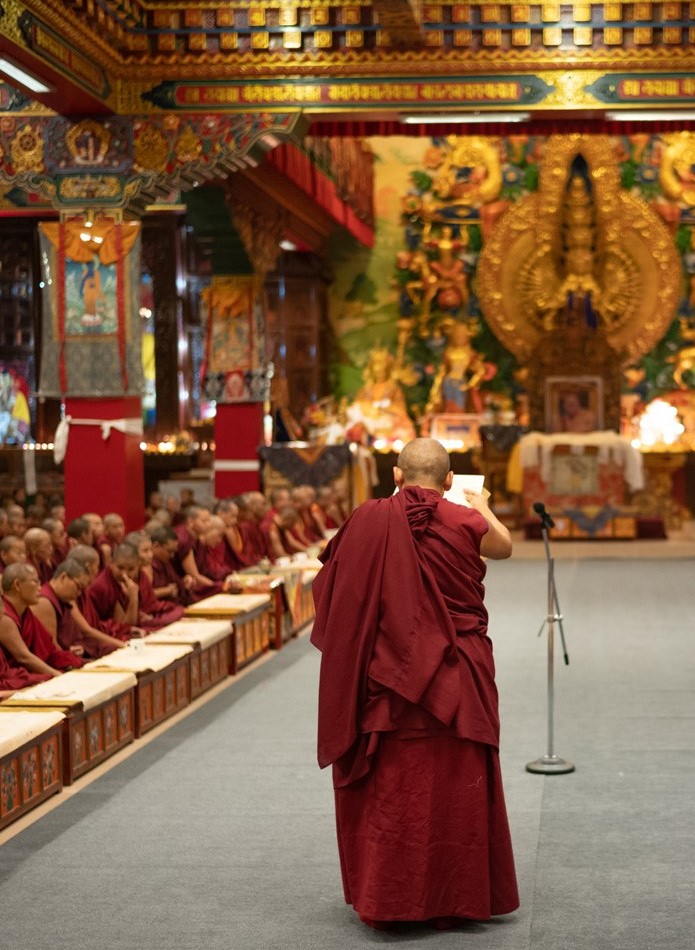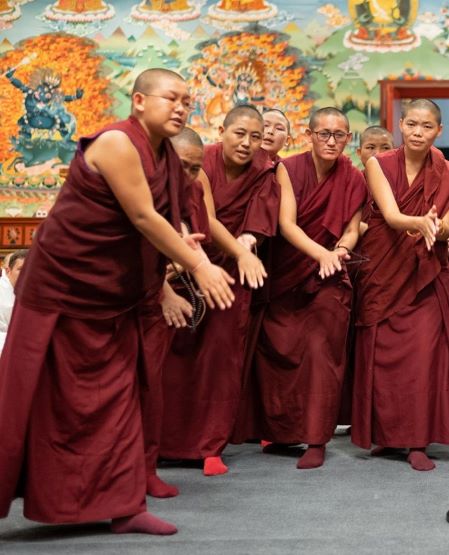A new class of nuns engages in fierce debates for the geshema, the highest degree in Tibetan Buddhism that was off limits to women for centuries.
Feb 07, 2019
With 80 candidates studying for the new and highly demanding geshema degree, the Khachoe Ghakyil Ling nunnery (also known as Kopan), in Kathmandu, is emerging as an important center of learning for a new generation of female Tibetan Buddhist leaders in the Gelug tradition. The increased attention on nuns’ education, including the geshema—Tibetan Buddhism’s highest degree, which has historically been limited to monks as the geshe—represents a major step forward and a significant departure from a long history of male dominance.
In a sea of burgundy robes, under the spectacular golden gazes of the 1,000-armed Chenrezig [the bodhisattva of compassion] and the 21 Taras [a female buddha], I and five other Western pilgrims made a hand-to-hand donation to each of nearly 600 nuns assembled in Kopan nunnery’s exquisite gompa, an assembly hall for devotion, celebration, and debate at the heart of the nunnery.
After the giving ceremony, we were invited to witness the annual Jang Gonchoe inter-nunnery debates, a monthlong festival where 600 nuns from nine nunneries around India and Nepal gathered to test their knowledge and skill in a centuries-old, highly energetic scholarly ritual.
Centuries old for monks, that is. For the nuns this vital rite of passage in Buddhist education was strictly off limits until 1995, when His Holiness the 14th Dalai Lama gave the women his blessing as the head of the Gelug lineage. Though it took some years for the traditionally unassuming nuns to gain the confidence needed for this kind of intense intellectual sparring, it’s clear from what we saw that night that they’ve taken to it like wildfire.
I was one of a group of 32 pilgrims on that auspicious October evening who came from the US, Canada, and Europe to learn about the nunnery and to lend our support. Organized by the American Buddhist teacher and author Miles Neale, our pilgrimage served the triple purpose of visiting the sacred sites of Padmasambhava—an eighth-century tantric master and a founder of Buddhism in Tibet—engaging in a week of intensive study at Kopan monastery, and benefitting the 380 nuns at Khachoe Ghakyil Ling. (Our pilgrimage also coincided with the launch of Neale’s book, Gradual Awakening, the proceeds of which are earmarked for the nunnery.)
 |
The energy was high and the atmosphere festive as about 15 Kopan debaters rose one by one, prostrated to the Buddha, and rushed to the back of the gompa to form a wide semicircle. In a dynamic call and response, the standing debaters lobbed their challenge to the opposing team, seated up front, in a unison call punctuated by a thunderous left-foot stomp (representing slamming the door on samsara, the cycle of death and rebirth) and handclap (representing the left arm of wisdom uniting with the right arm of compassion to eliminate confusion and suffering). Fierce and focused, the nuns clearly relished this exercise of their learning and skill, and so did the nuns seated cross-legged in the audience, some as young as seven years old, who were riveted to the action.
The significance of the debates to the nuns cannot be overstated. They mark a milestone in the evolution of Tibetan Buddhist women’s education and an important step on the path to the geshema degree, the first of which was awarded less than three years ago.
It takes 17 years of preparation to qualify for the ensuing four years of exams (each a grueling 11 days of written tests and oral debate) required to earn the degree, followed by another two years of tantric study. Since 2012, when the Dalai Lama and the Central Tibetan Administration, the Tibetan government-in-exile, gave the green light for the nuns to sit the exam, 37 nuns from 10 nunneries in India and Nepal have earned the degree; the first 20 degrees were conferred in 2016.
Related: Tibetan Nuns with Advanced Degrees Honored by the Dalai Lama
With the geshema, women have proven themselves perfectly capable of reaching the highest ranks of a formidably rigorous education. No surprise there, but it also represents a crucial step for the nuns in the areas of self-esteem and confidence building. Ven. Amy J. Miller, an American Buddhist nun in the Tibetan tradition and teacher who first studied at Kopan monastery in 1987, calls Khachoe Ghakyil Ling the “Oxford or Cambridge of nunneries” and observes that the nuns “have really come into their own. These are not the meek women I knew 20, 30 years ago.”
Thirty years ago there was no nunnery, only the Kopan monastery, where the “monks and nuns studied together,” said a Buddhist nun in the Gelug tradition who has been living at Kopan since before the split. “For 30, 40 years Kopan has been a support system for the nuns. They were raised here like brothers and sisters at the beginning and are still very close.”
 |
Kopan was unique in that women were encouraged from the outset, according to Mohoupt. Lama Zopa Rinpoche and Lama Thubten Yeshe, refugees from Tibet who met in India in the ’60s, founded the monastery with the help of their first disciple, Zina Rachevsky, a charismatic American actress and socialite turned nun, who was key in raising funds from the West. Still, confirms Mohoupt, “founding a nunnery was always a project.”
Though the nuns learned “side by side” with the monks at the monastery, they did not benefit from a structured program designed specifically with their needs and future in mind until the opening of Khachoe Ghakyil Ling, down the hill from the monastery, in 1994.
Kopan’s existing nuns were not the monastery’s sole motivation. A steady stream of refugee nuns and monks making the harrowing journey from Tibet desperately needed support and a place to go. As Tibetan Buddhist monasteries were already well established in Nepal and India, the nuns’ needs were the most urgent.
Lisa Farmer, executive director of the Tibetan Nuns Project US, emphasized these women’s dire predicament: “The nuns, when they first escaped from Tibet and came via Nepal to India—from 1987 onwards—were in very poor physical shape and of course they had nothing. They were traumatized and physically battered.” With few options available in a refugee community already stretched to its limits, these women faced extreme hardship and poverty.
The Tibetan Nuns Project was founded by Rinchen Khando Choegyal—who is the wife of the Dalai Lama’s younger brother—in 1987 to address the crisis. The organization has provided critical aid to Tibetan women and girls by building and supporting nunneries across Buddhist traditions.
While a robust education is crucial for women’s autonomy, said Farmer, “It’s not just about books. It’s also about helping nuns acquire the skills they need to run their own institutions and create models for future success and expansion. It’s about enabling the nuns to be teachers in their own right and to take on leadership roles in a critical time in their nation’s history.”
It is important to note that never in the history of Tibet have women had such educational opportunities. Even when Tibet was free, the nuns spent most of their time praying or meditating, rather than studying for advanced degrees, according to the Tibetan Nuns Project. Despite advances in housing and education, formidable challenges remain for the Tibetan nuns in exile. Topping the list is finding the funding to build accommodations for more girls and women, as well as for the upkeep of existing buildings.
But as women prepare to assume more leadership roles, education is still the most pressing challenge facing the nuns. At Kopan, along with the philosophy curriculum, the nuns are taught languages, including English, Nepali, and Tibetan, as well as math, science, and special courses in business for those who will help run the nunnery’s onsite incense factory. The focus on education underscores the importance of the geshema in terms of educating the teachers of the future and providing role models for the nuns. But hosting the Jang Gonchoe debates alone is a daunting expense. During the October–November 2018 debates, Kopan had 400 extra nuns to feed and accommodate for which a provisional outdoor kitchen had to be built. There is also all the equipment needed to keep up with the modern world: computers, software, maintenance, and virus protection. (Tibetan monastics are at particular risk of being targeted by Chinese hackers, according to numerous sources, including the Central Tibetan Administration.)
Late in the evening after the formal debates, scores of nuns of all ages gathered in Kopan’s wide courtyard laughing and chatting as they formed smaller groups to debate well into the night. My traveling companions and I said our good-byes, and as our bus lurched over the steep rutted hill back to the monastery, the mood was pure exhilaration. We knew we’d witnessed something monumental. Many of these women are already important role models and many more will be the teachers and leaders of the future. We couldn’t help but feel deeply inspired by their courage and optimism as they embrace an opportunity they have long been denied. Go back to E
With kind permission from Jennifer Ladone and Tricycle Magazine

